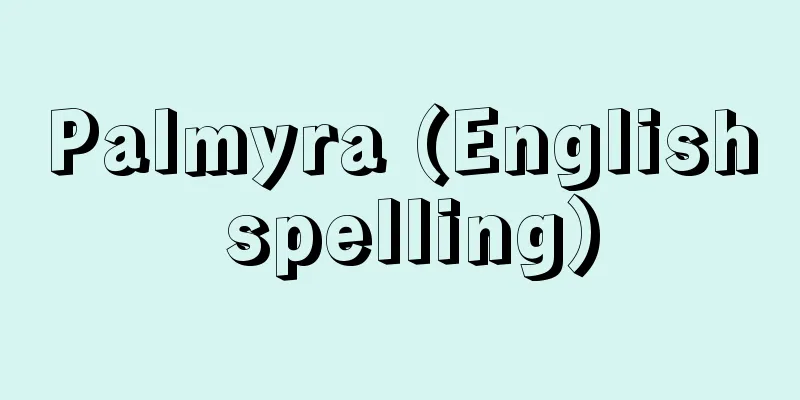Palmyra (English spelling)

A village centered on an oasis in central Syria. It is located about 210 km northeast of Damascus, at the northern edge of the Syrian Desert. It is also called Tadmor. In ancient times, it was known as a caravan city, and its inhabitants were mainly Arabs, but the language was Aramaic. It is said that it was founded by Solomon, but there is no evidence. It already appears in cuneiform documents from the 19th century BC. In the 3rd century BC, during the Seleucid period, signs of its rise began to appear, and in the 1st century BC, it rapidly developed as a trade transit city connecting Syria and Babylonia. In 106, it came under the control of the Roman Empire, but was allowed to govern itself, and commercial activity became even more active, becoming the largest caravan trade center in the Orient (→ Middle East). In the second half of the 3rd century, taking advantage of the conflict between Rome and Sassanid Persia, Odenathus and his family took real power, and his wife Zenobia declared independence, forming a caravan empire that stretched from Asia Minor to Egypt. For this reason, the city was destroyed by the Roman Emperor Aurelian in 272. It went into a steady decline thereafter, and was plundered by the Arabs and reduced to ruins. The development of Palmyrene religion was important, and in the 2nd century, monotheism of an "unknown god" was practiced. Today, the village is surrounded by date palm and olive orchards, and a pipeline runs through it from the Kirkuk oil fields in Iraq to Tripoli in Lebanon. The ruins from the Roman period (→Palmyra Ruins) still remain today, and there is also a museum. Population: 20,627 (estimated 1985). Palmyra |
シリア中部にあるオアシスを中心とした村。ダマスカスの北東約 210km,シリア砂漠の北端に位置する。タドモル Tadmorとも呼ばれる。古代には隊商都市として知られ,住民はアラブ人を中心としたが,言語はアラム語であった。ソロモンが建設したとも伝えられるが,証拠はない。すでに前19世紀の楔形文字の史料に現れる。前3世紀,セレウコス朝時代に興隆の兆しが現れ始め,前1世紀シリアとバビロニアを結ぶ貿易の中継都市として急速に発展した。106年ローマ帝国の支配下に置かれたが,自治を許され,商業活動はいっそう盛んになり,オリエント(→中東)最大の隊商交易の拠点となった。3世紀後半にローマとササン朝ペルシアの対立に乗じて,オデナトゥスとその一族が実権を握り,その妻ゼノビアが独立を宣言,小アジアからエジプトにまたがる隊商帝国を形成するにいたった。そのため 272年ローマのアウレリアヌス帝により滅ぼされた。以後衰退の一途をたどり,アラブに略奪され廃墟と化した。なお,パルミラ人の宗教の発展は重要で,2世紀には「知られざる神」の一神教が行なわれた。今日ではナツメヤシやオリーブの果樹園に取り巻かれた村で,イラクのキルクーク油田からレバノンのトリポリへ向かうパイプラインが通っている。ローマ時代の遺跡(→パルミラ遺跡)は今日も残存し,その博物館もある。人口 2万627(1985推計)。
パルミラ
|
<<: Halmstad - Halmstad (English spelling)
Recommend
Dom Pedro de Alcântara (English spelling)
…Emperor of Brazil. Reigned 1831-89. Seventh son ...
"Okusa Family Cookbook" - Okusa Family Cookbook
… The oldest cookbooks that exist today are the C...
Instant Ramen - Instant Ramen
A type of processed noodle product developed in J...
Pressure fixed point - pressure fixed point
...However, this method only allows for an approx...
Roundworm disease - Ascariasis
What kind of infection is it? Roundworms are worm...
Ryusuke Miyazaki
National Socialist activist. Born in Kumamoto Pre...
Hamaori - Hamaori
It is also called Isoasobi or Isomatsuri. It is he...
Kaimai (returning rice) - Kaimai
In the Edo period, this term referred to the trans...
Bishapur (English spelling)
…The front part of the building is a public area ...
Ivanov, Vyacheslav Vsevolodvich - Ivanov
...In the study of ancient records of Baltic myth...
Audiometer - Audiometer
The most widely used electrical device for hearin...
Koshiabura - Koshiabura
A deciduous tall tree of the Araliaceae family (A...
Georg Wilhelm Steller
1709‐46 German naturalist. Born in the Kingdom of ...
Hakka - Hakka (English spelling)
A group of Han Chinese who are said to have maint...
Otsu Castle
Hirajiro ( Mizu Castle) was located in Otsu City, ...









